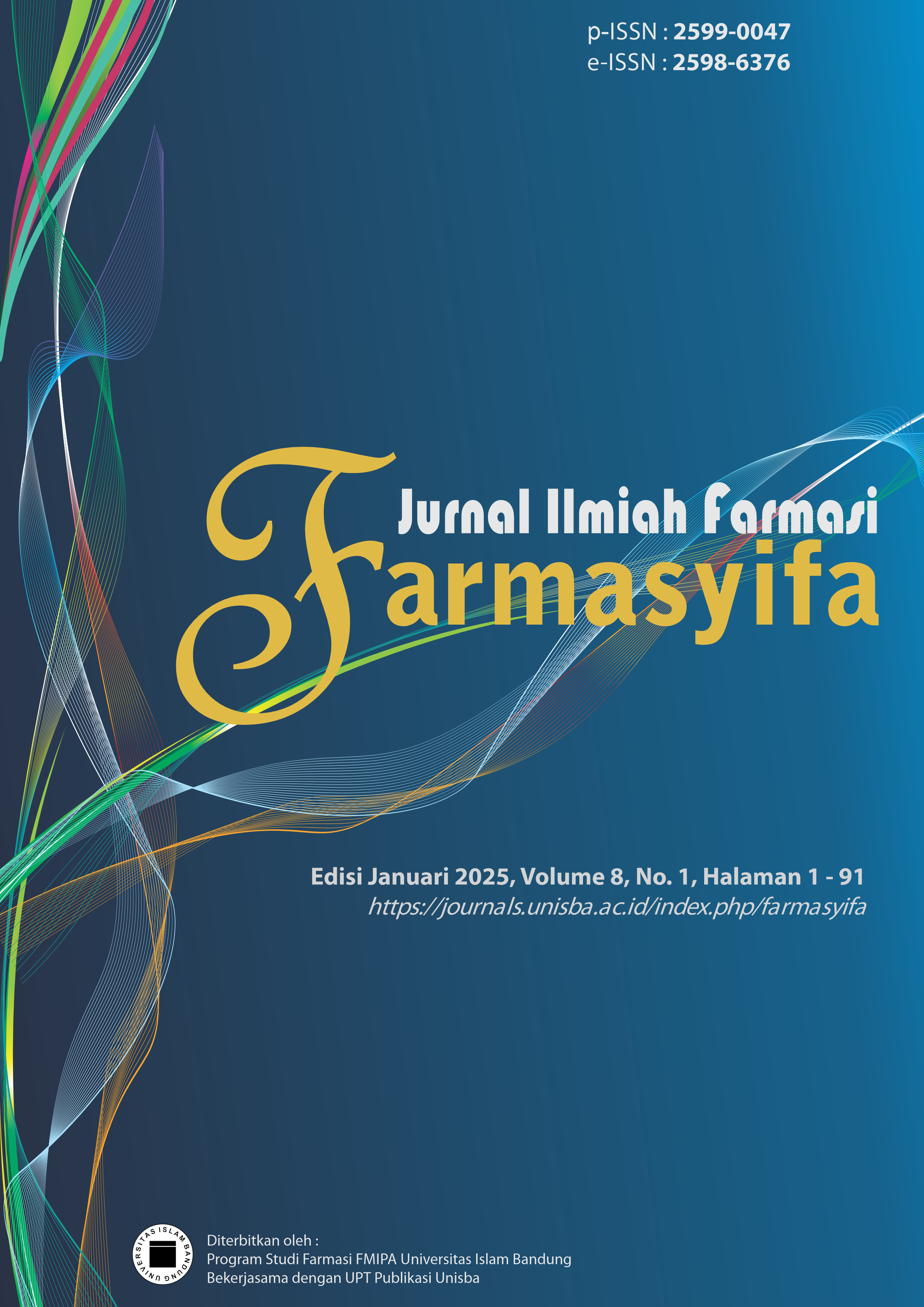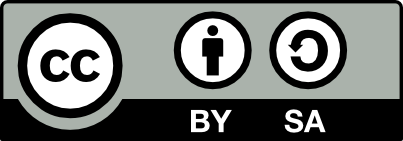Development of Emulgel Containing Benzoyl Peroxide and Citronella Oil (Cymbopogon nardus (L) Rendl) as Anti-acne Therapy
PENGEMBANGAN EMULGEL MENGANDUNG BENZOIL PEROKSIDA DAN MINYAK SERAI WANGI (CYMBOPOGON NARDUS (L) RENDL) SEBAGAI TERAPI ANTIJERAWAT
DOI:
https://doi.org/10.29313/jiff.v8i1.4500Keywords:
Benzoyl Peroxide, Citronella Oil, Cymbopogon nardus (L.) Rendl., Emulgel, Anti-acneAbstract
Acne is a inflammatory disease caused bacterium Propionibacterium, which can lead to inflammation and increased sebum production. Benzoyl peroxide (BPO) is an antibacterial used for acne. BPO, with concentrations in formulations ranging from 2.5-10%, has keratolytic and anti-inflammatory effects on acne and plays a role in reducing free radical oxygen and P. acnes density. The contents of citronella oil (Cymbopogon nardus (L.) Rendl.) Citronella, l-Limonene, Beta-Citronellol, Citronellyl acetate, trans-Caryophyllene, Geranyl acetate, Delta-Cadinene, Linalool, Germacrene D, (-)-beta.-Elemene. The aim of this study is to obtain an optimal emulgel formula containing BPO and citronella oil with anti-acne activity. The results of anti-acne activity testing against P. acnes and S. epidermidis obtained inhibitory zone diameters at a concentration of 5% citronella oil of 1.78 ± 0.15; ,09 ± 0 with positive controls 1.86 ± 0.07; 2.13 ± 0.09. The formulations were formulated with different Tween 80 concentrations as emulsifiers of 3%(F1); 5%(F2); 7%(F3) respectively. The formulations have a pH range of 5.0 – 8.0. The spreading power ranges between 5-7 cm. The viscosity of the formulations ranges from 40,000 – 60,000 cP. The diffusion test results yielded the best flux value of 653,723 mg/cm2. The best formula is indicated by F6 which consists of BPO 2.5%, Citronella Oil 5%, Carbomer-940 1%, Tween 80 3%, Propylene glycol 20%, TEA 0,05%, PEG-40 Hydrogenated Castor Oil 5%.
References
Alkilani, A. Z., McCrudden, M. T. C., & Donnelly, R. F. (2015). Transdermal drug delivery: Innovative pharmaceutical developments based on disruption of the barrier properties of the stratum corneum. Pharmaceutics, 7(4), 438–470. https://doi.org/10.3390/pharmaceutics7040438
Bauman, L. (2009). Cosmetic dermatology (Vol. 2). https://doi.org/10.1001/jama.1926.02670370006003
Bollinger, J. N., Lewis, D., & Mendez, V. M. (1977). Benzoyl Peroxide Stability in Pharmaceutical Gel Preparations. Journal of Pharmaceutical Sciences, 66(5), 718–722. https://doi.org/10.1002/jps.2600660528
Deswita, W., Manalu, K., & Tambunan, E. P. S. (2021). UJI EFEKTIVITAS ANTIBAKTERI EKSTRAK UMBI LOBAK PUTIH (Raphanus sativus L) TERHADAP PERTUMBUHAN BAKTERI Propionibacterium acnes DAN Staphylococcus epidermidis. KLOROFIL: Jurnal Ilmu Biologi Dan Terapan, 5(2), 111. https://doi.org/10.30821/kfl:jibt.v5i2.10032
Draleos, D. Z. (2016). Cosmetic Dermatology Products and Procedures. In John Willey & Sons (Second Edi). John Wiley & Sons, Ltd.
Eid, A. M., Naseef, H., Jaradat, N., Ghanim, L., Moqadeh, R., & Yaseen, M. (2023). Antibacterial and Anti-Acne Activity of Benzoyl Peroxide Nanoparticles Incorporated in Lemongrass Oil Nanoemulgel. Gels, 9(3), 1–12. https://doi.org/10.3390/gels9030186
Fianicha Shalihah, Saputra, A., & Sidiq, Y. (2023). Antibacterial activity of emulgel essential oil from scented lemongrass (Cymbopogon nardus (L.) Rendle) against Staphylococcus aureus ATCC-29213. Biogenesis: Jurnal Ilmiah Biologi, 11(1), 84–91. https://journal.uin-alauddin.ac.id/index.php/biogenesis/article/view/35836
Islam, M. T., Rodríguez-Hornedo, N., Ciotti, S., & Ackermann, C. (2004). Rheological characterization of topical carbomer gels neutralized to different pH. Pharmaceutical Research, 21(7), 1192–1199. https://doi.org/10.1023/B:PHAM.0000033006.11619.07/METRICS
Lertsatitthanakorn, P., Taweechaisupapong, S., Aromdee, C., & Khunkitti, W. (2006). In vitro bioactivities of essential oils used for acne control. International Journal of Aromatherapy, 16(1), 43–49. https://doi.org/10.1016/j.ijat.2006.01.006
Merry, A., Lisa, S., & Restry, S. (2021). Uji Aktivitas Antibakteri Hasil Fermentasi Kulit Buah Naga Merah (Hylocereus polyrhizus) terhadap Propionibacterium acnes. Jurnal Farmasi Sains Dan Terapan, 8(1), 1–7. http://journal.wima.ac.id/index.php/JFST/article/view/3086
National Center for Biotechnology Information. (2004). PubChem Compound Summary for CID 49792852. National Library of Medicine. https://pubchem.ncbi.nlm.nih.gov/compound/Calophyllolide
NA Sayuti. (2015). Formulasi dan Uji Stabilitas Fisik Sediaan Gel Ekstrak Daun Ketepeng Cina (Cassia alata L.). Jurnal Kefarmasian Indonesia, 5(2), 74–82.
Pratasik, M. C. M., Yamlean, P. V. Y., & Wiyono, W. I. (2019). FORMULASI DAN UJI STABILITAS FISIK SEDIAAN KRIM EKSTRAK ETANOL DAUN SESEWANUA (Clerodendron squamatum Vahl.). Pharmacon, 8(2), 261. https://doi.org/10.35799/pha.8.2019.29289
Priani, S. E., Dewi, W. K., & Gadri, A. (2019). Formulasi Sediaan Mikroemulsi Gel Anti Jerawat Mengandung Kombinasi Minyak Jinten Hitam (Nigella sativa L.) dan Minyak Zaitun (Olea europaea L.). Kartika : Jurnal Ilmiah Farmasi, 6(2), 57. https://doi.org/10.26874/kjif.v6i2.143
Rojas, L. A., Sethna, Z., Soares, K. C., Olcese, C., Pang, N., Patterson, E., Lihm, J., Ceglia, N., Guasp, P., Chu, A., Yu, R., Chandra, A. K., Waters, T., Ruan, J., Amisaki, M., Zebboudj, A., Odgerel, Z., Payne, G., Derhovanessian, E., … Balachandran, V. P. (2023). Personalized RNA neoantigen vaccines stimulate T cells in pancreatic cancer. Nature, 618(7963), 144–150. https://doi.org/10.1038/s41586-023-06063-y
Shahbazi, M., Jäger, H., Ettelaie, R., & Chen, J. (2021). Construction of 3D printed reduced-fat meat analogue by emulsion gels. Part I: Flow behavior, thixotropic feature, and network structure of soy protein-based inks. Food Hydrocolloids, 120(June). https://doi.org/10.1016/j.foodhyd.2021.106967
Tuchayi, S. M., Makrantonaki, E., Ganceviciene, R., Dessinioti, C., Feldman, S. R., & Zouboulis, C. C. (2015). Acne vulgaris. Nature Reviews Disease Primers, 1(1), 15029. https://doi.org/10.1038/nrdp.2015.29
Zheng, N., Zhu, J., Yang, Z., Jiang, Z., Li, X., Zhang, L., Li, Q., & Wen, Y. (2024). Study on the key performance and stabilization mechanism of viscoelastic scCO2 foams: The formation of pseudo-gemini surfactants,. Journal of Molecular Liquids, 399(ISSN 0167-7322). https://doi.org/https://doi.org/10.1016/j.molliq.2024.124477.
Downloads
Published
How to Cite
Issue
Section
License
Copyright (c) 2025 Hanifa Rahma, Farendina Suarantika, Pedriantini Iqlima Subekti, Chika Puspitasari

This work is licensed under a Creative Commons Attribution-ShareAlike 4.0 International License.






















